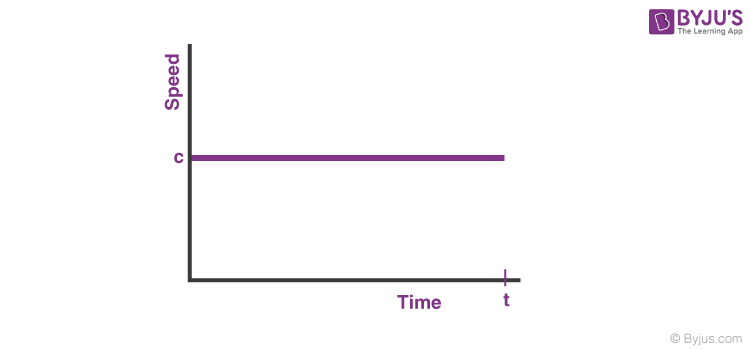We have learnt about what speed and velocity are and the difference between the two. Now, we will learn about speed-time graphs and velocity-time graphs.
Speed – Time Graphs
We know that the speed at a certain time is the magnitude of the velocity at that time. So we can follow equations of motion to draw speed time graphs.
Case 1: Speed-time graphs with constant speed (zero acceleration)
When the speed is constant, the speed time graph, with Y-axis denoting speed and the X-axis denoting time, will be like this:

Time graph for constant speed
Speed-
As clear from the graph, the speed is constant (c) throughout the time interval. No matter how much the time changes, the speed will be c at every instant.
Example: If the acceleration of a particle is zero (0), and speed is constant, say 5 m/s at t =0, then it will remain constant throughout the time.
Read More: Velocity
Case 2: Speed-time graphs with constant acceleration
When the acceleration is constant, and the initial speed of the particle is zero, the speed of the particle will increase linearly, as predicted by the equation:
v = u + at
Since u = 0
v = at

Speed-Time graph with constant acceleration
As shown in the figure, the speed of the particle will increase linearly with respect to time. The slope of the graph will give the magnitude of acceleration.
Example: If the acceleration of a particle is constant (k) and the initial speed is zero, the speed increases or decreases linearly. The slope of the speed-time graph will give the magnitude of acceleration (k).
Case 3: Speed-time graphs with increasing acceleration
When the acceleration increases with time, the speed time graph will be a curve, as predicted from the equation:
v = u + at
Since u = 0
v= at
Since acceleration is a function of time, the speed time graph will be a curve.
Note: Since the acceleration is continuously increasing with time, the magnitude of the slope will also continuously increase with time.

Speed-time graph with increasing acceleration
Example: If the acceleration of a particle is a function of time and the initial speed is zero, the speed-time graph will be a curve. The slope of the speed-time graph at any instant (at a certain time) will give the magnitude of acceleration at that time. Case 3 is just the case of increasing acceleration. There will be a different graph when the acceleration decreases with time.
Stay tuned with BYJU’S to learn more about speed time graphs, motion graphs and much more.
Frequently Asked Questions – FAQs
What is velocity?
What is speed?
How many types of speed are there?
- Uniform speed
- Variable speed
- Average speed
- Instantaneous speed
What is instantaneous speed?
Define average velocity.
Complete quiz of the chapter Motion Class 9 Science

Top 10 NTSE Important Questions on Motion Class 9



i like this website